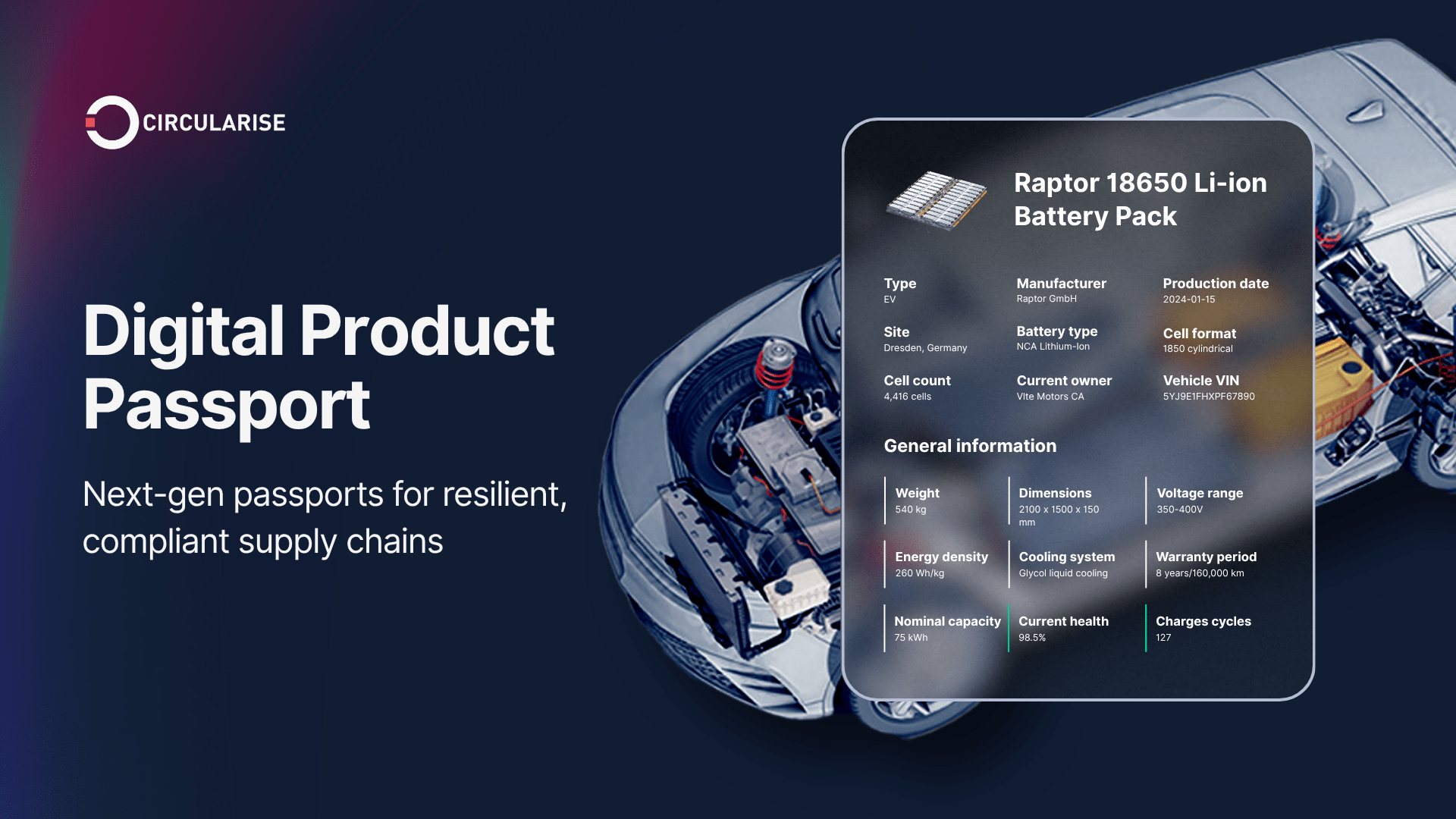Scalability and interoperability are at the heart of many unanswered questions about digital product passports. These factors will dictate if digital product passports will become a widely adopted asset and lead to their success in facilitating the shift to a more circular economy.
In this article we will discuss the key considerations you need to make when implementing digital product passports, and what you can start doing now to make sure your system is scalable.
What are the key considerations to ensure a digital product passport system is scalable?
For digital product passports to be rolled out at scale, the creation and maintenance of DPPs will need to be automatic. When a product is manufactured, assembled, shipped, serviced, and processed at end-of-life, data needs to be automatically pulled from the ERP and other systems and pushed to digital product passports. To establish this automation, systems must follow the same sets of rules and speak the same language, which can be broken down into five key factors:
1. For information to be found, it must be stored in robust databases
Certain data points in digital product passports may need to be synchronised with EU databases, but it is unlikely that regulation will dictate exactly where the primary data in a digital product passport is stored. Companies must therefore decide themselves if they are going to develop their own system to store the data locally or in their own cloud environment.
Alternatively, (and most likely) companies that don’t wish to develop their own system will need to choose a digital product passport service provider who either:
- Stores their data for them in a centralised database (cloud or centralised blockchain)
- Stores their data in a decentralised database (decentralised blockchain)
- Or stores their data in a hybrid of the two (e.g. a cloud database which hashes its state to a blockchain)
Each approach to data storage presents a set of challenges to achieving interoperability if an open protocol that allows different digital systems to talk to each other is not universally adopted. For any of these data storage options, interoperability between systems used by other parties in their specific value chain must also be considered. There will be no one solution that fits the requirements of all industries and use cases, but the key will be ensuring that these systems are still interoperable.
Please note that where the data is stored should not be confused with the unique identifier used, such as the QR code that links to the digital product passport. The QR code itself does not store any product information other than the product identifier. The identifier links to a record stored in a database, where all the product data is stored. This means that any unique identifier can be used with any type of database.
2. For DPP systems to connect together smoothly, they must use the same communication protocols (or continually maintained APIs)
A protocol is a set of rules that determine how data is transmitted between connected devices, regardless of differences in internal processes, structure, or design. If two digital product passport systems use different communication protocols, then they will not be able to communicate with each other without the use of an API to translate the two data sets. This API must also then be continually updated to ensure no errors occur when either protocol changes. Maintaining APIs between systems becomes exponentially more difficult when more protocols are introduced.
Ideally, an open protocol (such as Act B) will be universally adopted so that different applications can communicate with each other, much like email. Regardless of your email service provider, you are still able to send and receive emails from others using different providers. To facilitate interoperability, a similar open protocol should be adopted for digital product passports.
3. For data to be secure, it should be securely stored and selectively shared
Data storage and access will also define the overall security of the data stored in digital product passports. If all data is made public, then this is not a concern. There is a proportion of the digital product passport that must be made public so that consumers can access the data. This means that these data points must be available to anyone with an internet connection, without the need to download or sign into a third-party service.
However, there is also the need for companies to selectively share some data with known parties, so that confidentiality can be maintained. One way this can be done is by adding user-dependent permissions to the database and relying on encryption to keep data secure from unauthorised access.
Selective data sharing becomes challenging when a company not known to the original owner of the data needs to access data in the digital product passport. For example, when a manufacturer does not know where their product ends up being sold, and a recycler later needs access to the private data. This would mean the recycler either needs to retrospectively request the required information – which is not automated or scalable – or somehow validate they are part of a permissioned group of users (e.g. all verified recyclers can access certain data). The latter option would mean all users in this group could then see all the data. But as the value chain is not always clearly defined in its roles, creating user permissions for whole groups of companies can quickly lead to data leaks, which means competing parties could see each other's information.
While selective data sharing presents some major challenges, it is necessary to get information to those that need it while protecting sensitive data. Digital product passports cannot facilitate the transition to a circular economy if all the data is locked in private centralised databases and cannot be accessed by those who need the information.
4. For data to be reliable, a balance of static and dynamic data must be established
A combination of static and dynamic data is required to maintain a source of truth for fixed facts, while maintaining a live status of variable factors. Static data will be important for ensuring that certain unchanging facts about a product remain constant. While dynamic data will be useful for maintaining information on variable data such as the live status or performance of a product.
The use of primary data (information an entity collected themselves) is equally important to ensure that unreliable estimates and averages are not used, while ensuring the data can be kept up-to-date as a single source of truth. For example, the greenhouse gas emissions associated with a batch of raw material extracted from a mine is a fixed figure once added and should not be altered. But the performance of an electric vehicle battery is a continually changing parameter which needs to either be automatically updated or updated periodically by a servicing party. In both cases the data entered should be from primary sources. For example, the emissions associated with that batch of material need to be specific to the site it was extracted from and the methods used, not calculated using estimates. And the battery performance should be measured by sensors in that vehicle, not an indication based on a modelled average scenario.
Practically speaking, this means systems containing relevant data must be connected to one another, with predefined rules for pushing and pulling data. Data in the ERP system is a large focus of this connectivity, so APIs and webhooks will need to be utilised so that data can automatically flow to digital product passports. Other key sources of data for digital product passports will also come from machine data, energy consumption metres, and LCA databases1.
5. For data to be comparable, it needs to be obtained and audited following set methods and standards
A wide variety of data can be included in a digital product passport, but for these insights to be reliable and comparable, the procedures for data collection and calculation must follow set methods3. When standard techniques are followed, processes can then be audited by third parties, creating reliable data sets. This is where aligning data in digital product passports to existing standards and certification schemes is key1.
Without alignment of methodologies, it means that data from different sources is not comparable. For example in the plastics industry, product carbon footprint figures are now starting to be provided with products. However, when different polymer manufacturers use different life cycle assessment (LCA) scopes and methods to calculate the greenhouse gas emissions associated with their products, the product carbon footprint figures from the different manufacturers cannot be reliably compared. Without the technical knowledge of LCA methods, buyers cannot make a fair comparison of impact statistics, making the product impact claims made by suppliers unreliable and misleading.
There are a range of different initiatives such as Pathfinder and Together for Sustainability (TfS) working to create frameworks for calculating product, company, and country-level impacts in a standardised way. The different standards focus on different areas of environmental impact and at different scopes, therefore you should pay attention to the industry-specific standards and regulations relevant to you.

What can you do now to prepare for digital product passport implementation?
Many of the points discussed in this article depend on aligning a common approach to digital product passport systems with the value chain, further demonstrating the importance of collaboration in setting up digital product passports. In addition to starting conversations with your value chain about digital product passports, you can investigate existing frameworks and working groups that are working to build on industry standards for data connectivity so that you can take a unified approach.
There are also several actions that need to be taken individually to ensure your internal systems are ready to support a scalable digital product passport system. It is unlikely that you will need a whole new IT system, just an additional software layer for the management of digital product passports1. To prepare for getting this set up in a scalable and reliable manner, you can start with these steps:
- Make sure you have all of your product data required for the digital product passport. If the information on your operations is missing, start creating a plan to collect this data.
- Ensure all product data in your systems follows a uniform format and is stored in a single location or in systems that can be easily interconnected. If the systems are not interoperable, create a plan for integrating the data sources in a unified format. This is also the case for information from your suppliers which will need to be integrated, meaning you need to create a plan for the different read and write permissions for internal and external users.
- Review your cyber security procedures to ensure that data can be pushed and pulled to a digital product passport system using secure ports without increasing the risk of a data breach.
- These factors also mean you need to create a plan for exactly where the various groups of data will be stored and therefore who has ownership of it.

Circularise is the leading software platform that provides end-to-end traceability for complex industrial supply chains. We offer two traceability solutions: MassBalancer to automate mass balance bookkeeping and Digital Product Passports for end-to-end batch traceability.








